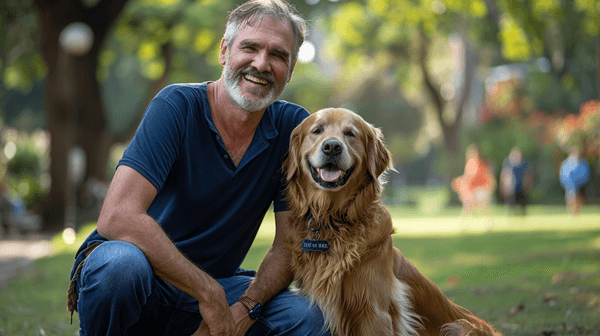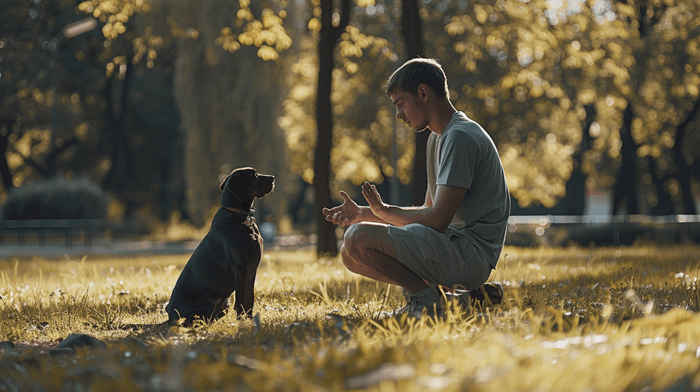
Training your dog is one of the most rewarding aspects of pet ownership, but it’s often overlooked. A well-trained dog isn’t just a delight to have around; it also significantly improves their quality of life and strengthens the bond between you and your furry friend. Whether you’re training a new puppy or trying to improve an older dog’s behavior, dog training provides structure, discipline, and mental stimulation. In this article, we’ll explore the benefits of dog training, offer a step-by-step guide for beginners, and address common mistakes that pet owners make when attempting to train their dogs.
The Importance of Dog Training:

Dog training isn’t just about teaching tricks or getting your pet to follow basic commands; it’s about establishing a respectful, trusting relationship. An untrained dog may exhibit behavioral problems, leading to frustration for both the pet and the owner. Conversely, a trained dog is not only happier but also healthier due to the mental and physical engagement that training provides. Let’s explore five essential reasons why dog training should be a priority for every pet owner.
Five Benefits of Dog Training:
Improves Behavior and Manners
A well-trained dog is less likely to engage in undesirable behaviors such as chewing, barking excessively, or jumping on guests. By establishing clear boundaries and expectations, you give your dog the tools to behave properly in various situations.
Enhances Safety for Your Dog and Others
A dog that listens to basic commands like «sit,» «stay,» and «come» is far less likely to run into dangerous situations, such as traffic. Moreover, well-trained dogs are easier to control in public spaces, reducing the risk of harm to themselves or others.
Strengthens the Bond Between Dog and Owner
Training your dog isn’t just about obedience—it’s about creating a mutual understanding. When your dog learns to follow your commands, they’re also learning to trust and respect you. This builds a strong emotional connection and promotes a positive relationship.
Provides Mental Stimulation and Physical Activity
Dogs thrive when they are mentally and physically stimulated. Training challenges their brains and bodies, preventing boredom and reducing the likelihood of destructive behaviors like digging or excessive chewing.
Socialization and Adaptability
A trained dog is more likely to be well-socialized, which means they can handle new environments, people, and animals with ease. This adaptability makes trips to the vet, park, or even on vacation far more enjoyable for both the dog and the owner.
Step-by-Step Guide to Dog Training:
1. Start With Basic Commands
The foundation of dog training lies in mastering basic commands like «sit,» «stay,» «come,» and «leave it.» Focus on one command at a time and use short training sessions of about 10-15 minutes to keep your dog engaged.
2. Use Positive Reinforcement
Reward-based training is proven to be the most effective. Always reward good behavior with treats, toys, or praise. This reinforces the connection between the command and the desired action. Avoid using punishment, as it can create fear and confusion.
3. Stay Consistent
Consistency is key in dog training. Make sure all family members use the same commands and reward system to avoid confusing the dog. Additionally, train in different environments to help your dog generalize the behavior.
4. Practice Patience
Training takes time. Some dogs may grasp new commands quickly, while others may require more repetition. Stay patient, avoid frustration, and remember that every dog learns at their own pace.
5. Socialize Early
Introduce your dog to a variety of environments, people, and other animals as early as possible. Socialization helps prevent behavioral issues like fear or aggression, making your dog more adaptable and confident.
Common Dog Training Mistakes and How to Avoid Them:

1. Inconsistent Commands
If one person says «sit» and another says «down» for the same action, your dog will get confused. Stick to one word per command, and ensure everyone in the household uses it consistently.
2. Training Without Rewards
Dogs respond best to positive reinforcement. If you don’t reward good behavior, your dog may not understand what you’re asking them to do. Always have treats or praise ready when they follow commands.
3. Skipping Socialization
Neglecting to socialize your dog can lead to long-term behavioral issues. Dogs that aren’t exposed to other people and pets are more likely to develop anxiety or aggression.
4. Rushing Through Training
Rushing your dog through training sessions or skipping steps can backfire. Make sure your dog has mastered one command before moving on to the next, and reinforce old commands regularly.
5. Overtraining
Dogs, like humans, need breaks. Overtraining can lead to frustration and burnout for both the owner and the dog. Keep sessions short and fun to maintain motivation and focus.
Scientific Support for Dog Training:

Research consistently shows the benefits of dog training for both the pet and the owner. Studies indicate that positive reinforcement is the most effective method for teaching new behaviors, and it strengthens the dog-owner bond. For example, a 2020 study published in the Journal of Veterinary Behavior found that dogs trained with positive reinforcement had higher levels of compliance and lower stress levels compared to those trained with aversive methods. Another study from 2018 in Applied Animal Behaviour Science confirmed that early socialization plays a critical role in preventing aggressive behaviors in dogs.
Conclusion
Training your dog is an essential part of ensuring they live a happy, healthy, and balanced life. With the right techniques and a lot of patience, any dog can learn to behave well and enjoy the process. Remember, it’s never too late to start training, whether you have a puppy or an adult dog. If you’re ready to take your dog’s training to the next level, consider getting our digital book, «Dog Trainer Bible.« This comprehensive guide covers everything from basic commands to advanced behavior training, all using positive reinforcement techniques. Start today and transform your dog’s behavior with the «Dog Trainer Bible»!
